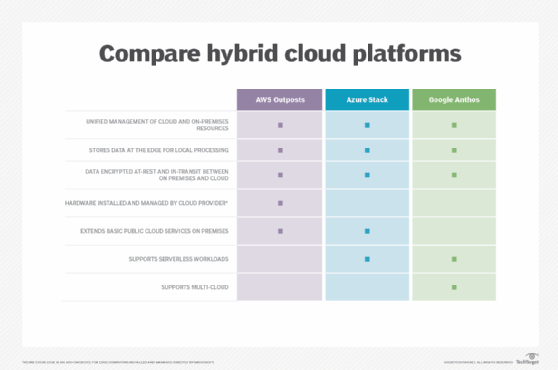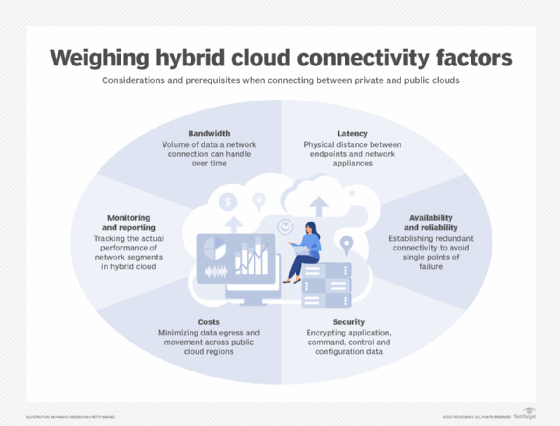Top enterprise hybrid cloud management tools to review
The techniques used to build hybrid cloud architectures have come a long way, but managing these environments long term is plenty more complex without the right software.
Modern hybrid cloud frameworks extend public cloud services into private infrastructure. While these capabilities make building a hybrid cloud easier, the bigger challenge is assembling a tool set that enables effective management of hybrid cloud over the long term. Regardless of how a hybrid cloud environment is designed, several tools are needed to handle administration, performance optimization, cost management and security.
Why hybrid cloud management matters
In recent years, public cloud vendors have rolled out a new generation of frameworks for the creation of hybrid clouds -- most notably Azure Stack, Azure Arc, AWS Outposts and Google Cloud Anthos. At the same time, more conventional management platforms for hybrid cloud, such as VMware Cloud Foundation and Cisco Intersight, continue to thrive. In addition, Kubernetes can be useful as an element of hybrid cloud management, especially for organizations that use Kubernetes services, like Elastic Kubernetes Service (EKS) Anywhere, to manage workloads deployed on private infrastructure using Amazon's managed Kubernetes service.
These platforms provide a centralized way to deploy and administer workloads across a cloud environment that mixes private infrastructure with public cloud resources. Integration between these entities is a significant improvement over earlier hybrid cloud architectures, which looked more like a private cloud and a public cloud running side by side.
The creation of a hybrid environment has become easier, so it might be tempting to think that managing hybrid clouds is no longer a major challenge. Modern hybrid cloud platforms simplify and centralize the deployment of public cloud services on private infrastructure, but they don't address all aspects of hybrid cloud management. Their native management tooling has limited scope. Even the needs they address, such as log management, might require additional functionality beyond what's available in the built-in tools.
Evolution of hybrid cloud management tools
For most of the 2010s, hybrid cloud management was dominated by established infrastructure providers, such as Cisco and Dell, which offered hybrid cloud platforms and tooling that integrated with their products. At the same time, some startups vied to provide limited capabilities for managing hybrid clouds by offering features that the infrastructure providers lacked.
But, today, public cloud vendors have themselves become major players in the hybrid cloud market alongside traditional infrastructure vendors, like Dell. All these entities offer not only software for building hybrid clouds, but also management tools. At the same time, independent vendors continue to sell hybrid cloud management tools that can complement or replace the tooling offered by infrastructure providers.
The expansion into tiers of cloud management capabilities also has encouraged market consolidation. For example, VMware acquired CloudHealth, Flexera purchased RightScale and Snow Software bought Embotics.

Types of hybrid cloud management tools
The hybrid cloud management landscape is complex. Tools have overlapping functionality. And, since hybrid cloud architectures come in many forms, not all tools apply to all hybrid cloud configurations.
That said, hybrid cloud management tools are generally categorized as one of two types of tools:
- Native tools built into frameworks for building hybrid cloud.
- Third-party tools integrated with hybrid environments but not built into them.
Native hybrid cloud management tools
The first category of management tools consists primarily of public cloud services that can extend into hybrid cloud environments. For example, if AWS Outposts is used to build a hybrid cloud architecture, the AWS public cloud's standard management tools, including CloudWatch and CloudTrail, can be used to help monitor the hybrid environment and manage logs. Azure Stack provides a similar experience by integrating with the Azure public cloud's standard monitoring tools. So does Anthos, using Google Cloud Console.
Platforms such as VMware Cloud Foundation and Kubernetes can be tied into some public cloud vendors' services. But, for the most part, they don't extend public cloud management tooling into hybrid environments. Instead, users manage hybrid environments via the native tooling that's built into the platforms, such as kubectl on Kubernetes. That said, some integrations between these platforms and public cloud platforms exist. It's possible, for example, to use the AWS Identity and Access Management framework to govern some permissions within Kubernetes environments hosted by using Amazon EKS.
Third-party hybrid cloud monitoring and management tools
Because of the limitations in native hybrid cloud management tools, it's sometimes necessary to add management tools from third-party vendors. These tools may provide broader and richer functionality. They also offer the advantage of working across multiple cloud platforms at once, which is usually not the case when using cloud provider tools. This capability makes third-party hybrid cloud tools useful for businesses whose cloud strategy includes multiple public clouds in addition to a hybrid cloud.
Physical infrastructure integration and management
Hybrid cloud management isn't just about digital assets. It also extends to the physical hardware that hosts hybrid cloud. It's necessary to keep track of the servers, which hardware resources they provide and whether they're adequate to meet the hybrid cloud architecture's needs. Cloud providers have extended their reach to on premises by bundling hardware with services and linking back up to their clouds. These products eliminate the need for an enterprise to manage physical infrastructure. But, sometimes, there are tradeoffs. With AWS Outposts, the servers must be acquired directly from AWS. On other hybrid cloud platforms, however, a company typically purchases and manages its own hardware.

Evaluation criteria for hybrid cloud management tools
The way an organization builds its hybrid cloud plays a key role in determining which management tools are effective.
Whether used in a public cloud or a hybrid environment, native cloud monitoring and cloud management tools typically offer limited features and integrations. Kubernetes' native logging and monitoring features, for example, are useful for taking a quick peek at recent log data, but they lack the automation capabilities necessary to work well at scale, which must come from additional external tools. Likewise, CloudWatch and CloudTrail help with basic monitoring needs, but they don't provide the sophisticated visualization or customization features required for complex management needs. They also work only with infrastructure that is hosted in AWS or part of a hybrid cloud based on AWS Outposts.
For third-party hybrid cloud management tools, first consider whether they fully support the company's hybrid environment. Some logging and monitoring tools may work with the public cloud platform on which the hybrid cloud is partly based, but they may not work well or at all with the abstraction layer, such as Kubernetes or Cloud Foundation, that's run on top of it.
Also, consider whether to choose management tools that work with other parts of the IT infrastructure, not just the hybrid cloud. For instance, log aggregation and analytics tools that work with any type of on-premises environment or public, private or hybrid cloud will aid the company's efforts to centralize and simplify log management. The same is true of security monitoring and incident management tools, as well as cost optimization products, that are used with the hybrid cloud environment.
Hybrid cloud hardware management can be simplified to a certain degree by using monitoring products. Nagios, Zabbix and similar tools work with physical hardware, as well as virtual environments, enabling a team to monitor the physical and virtual layers of the cloud environment in one product. It's still necessary to keep track of physical asset ownership and lifecycles as part of an IT asset management process, which is distinct from the tools used to monitor and manage VMs and other hybrid cloud resources.
Top hybrid cloud management tools
Hybrid cloud management tools represent a complex ecosystem. These products are likely to continue to evolve, as will hybrid cloud platforms themselves.
Besides the hybrid cloud platforms previously mentioned, there are specific tools for managing workloads in a hybrid cloud setup. The following are three of the major cloud providers offering their own native tools:
- AWS CloudFormation, Amazon CloudWatch and AWS CloudTrail.
- Microsoft Azure Automation and Azure Monitor.
- Google Cloud Console.
Several third-party vendors also offer tools for this purpose, including the following:
- CloudBolt Software.
- CloudSphere.
- Flexera.
- IBM Cloud Pak for Multi Cloud Management.
- Micro Focus Hybrid Cloud Management X.
- Morpheus Data.
- Scalr.
- Snow Software (Embotics).
- VMware Tanzu CloudHealth and Tanzu Observability.
Make sure the tools work with all parts of the IT infrastructure and cover all the related management needs -- something that native management tools built into hybrid cloud frameworks sometimes can't do.
Chris Tozzi, senior editor of content and a DevOps analyst at Fixate IO, has worked as a journalist and Linux systems administrator with particular interest in open source Agile infrastructure and networking.








